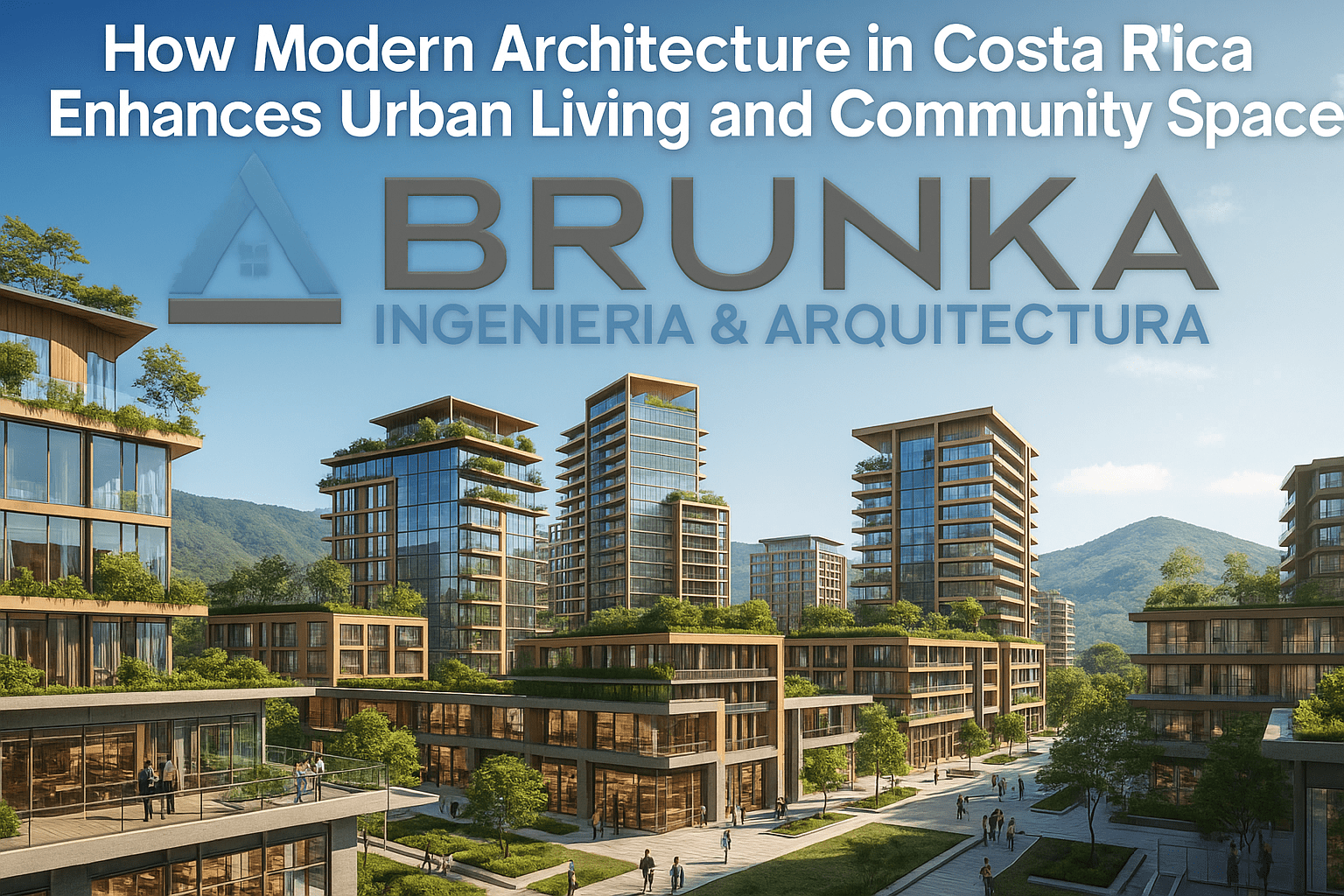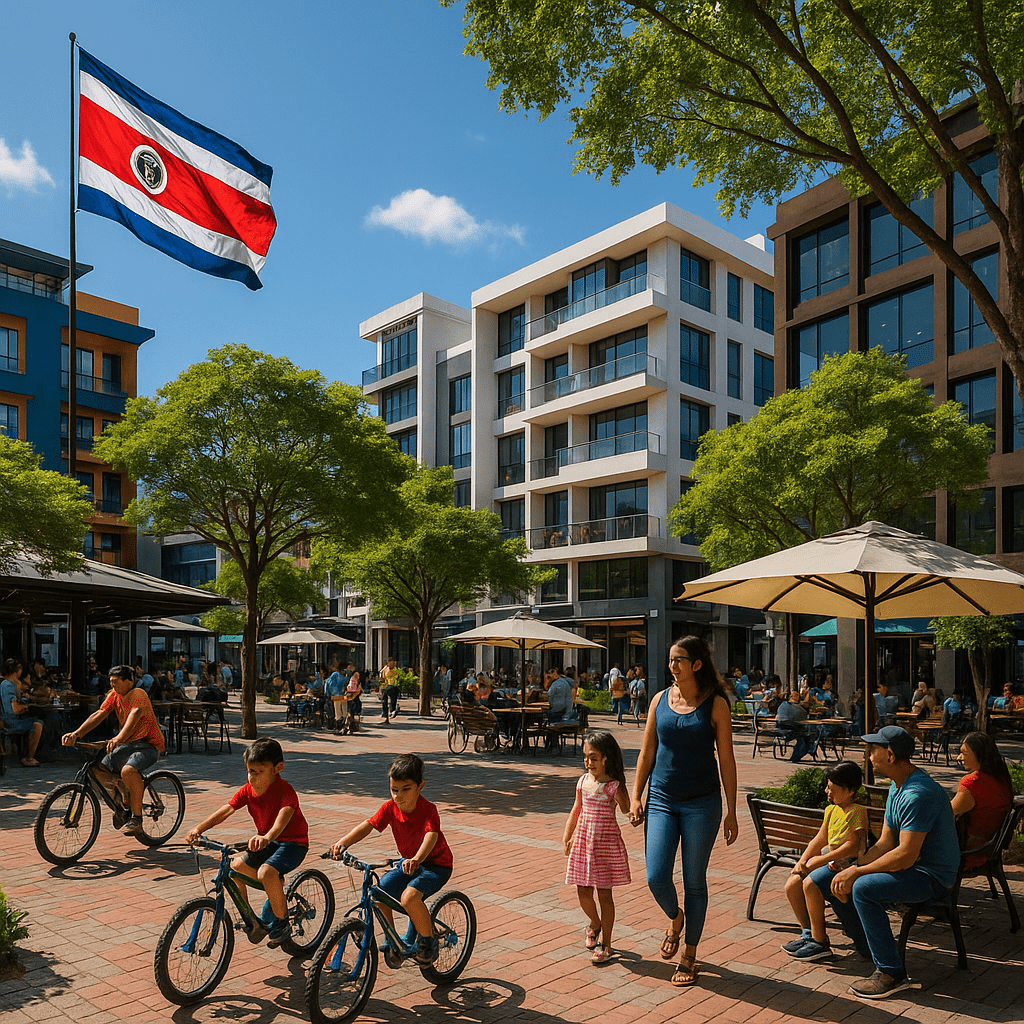
How Modern Architecture in Costa Rica Enhances Urban Living and Community Spaces
Summary
- Costa Rica’s cities are embracing modern architecture that blends sustainability with lifestyle.
- Mixed-use buildings are redefining how people live, work, and connect.
- Green spaces and passive cooling are now integrated into urban projects.
- Smart design is tackling challenges like traffic, density, and heat.
- Community-focused architecture is shaping a new social identity for Costa Rica’s urban future.
From Urban Sprawl to Human-Centered Design: A New Era
I’ve spent years immersed in Costa Rica’s architectural landscape, and I’ve witnessed a profound shift. The old model of urban development—unplanned sprawl and isolated residential compounds—is giving way to something far more thoughtful and exciting. In 2025, modern architecture isn’t just about constructing buildings; it’s a strategic tool for enhancing community spaces and enriching urban life. This isn’t just about creating beautiful structures; it’s about solving real-world problems like social disconnection, environmental degradation, and resource scarcity. The new architectural philosophy is inherently a human-first approach, one that prioritizes shared spaces, pedestrian-friendly design, and a deeper integration with the environment. It’s a fundamental move from building for private ownership to designing for public well-being, and the results are redefining what it means to live in a modern Costa Rican city.
The Biophilic City: Weaving Nature into the Urban Fabric
For too long, cities have been concrete jungles. Modern Costa Rican architects are actively dismantling that concept by using biophilic design to reconnect urban dwellers with nature. This isn’t just about adding a few park benches; it’s a systemic integration of green spaces that improves mental health, air quality, and social cohesion.
- Vertical Gardens and Green Roofs: In high-density areas, buildings are becoming living ecosystems. Vertical gardens and green roofs are not only aesthetically pleasing but also serve crucial environmental functions, like managing stormwater runoff and reducing the urban heat island effect.
- Pocket Parks and Green Corridors: Small, underutilized spaces are being transformed into pocket parks. These accessible green oases provide a sanctuary for relaxation and community gathering. By connecting these parks with green corridors, architects are creating a network of natural pathways for pedestrians and cyclists, encouraging healthier lifestyles and reducing reliance on cars.
This approach is best illustrated by the “Ciudad Dulce” program in Curridabat, a model of urban planning that aligns infrastructure with biodiversity. It’s an example of how a city can be a productive ecosystem, not a consumer of resources.

The Third Place: Reimagining Community Spaces
The term “third place” refers to social surroundings separate from the two typical social environments of home (“first place”) and work (“second place”). Modern Costa Rican architecture is placing a renewed emphasis on creating these vital communal spaces.
- Mixed-Use Developments: The days of single-purpose buildings are over. New developments are seamlessly blending residential living with commercial spaces, creating vibrant hubs where residents can live, work, and socialize without ever having to get in a car. These ground-floor retail spaces, cafés, and public squares become informal meeting points that naturally foster community bonds.
- Community Centers and Urban Plazas: Modern community centers are designed as dynamic, multi-functional spaces that adapt to a variety of needs, from hosting local markets to providing a shelter during natural disasters. The new community center in El Rodeo de Mora, for example, was built using locally-sourced materials and a circular design that promotes natural air circulation. This type of architecture is not just a building; it’s a piece of social infrastructure.
These community-centric designs enhance social connectivity and create a sense of belonging, which is a powerful antidote to urban isolation. The result is a more resilient, engaged, and happier populace.
Real Result: A residential complex in Santa Ana reduced indoor temperatures by 5°C (41°F) without added energy costs simply by integrating shaded courtyards and cross-ventilation.
If you’re planning urban development, our architecture services in Costa Rica can help design mixed-use spaces that balance commercial success with livability.
Sustainable Solutions: Architecture as a Force for Good
Costa Rica’s commitment to environmentalism is being woven into the very fabric of its urban centers. Modern architecture is embracing sustainability not as a marketing gimmick but as a core tenet of responsible development.
- Passive Systems: Architects are masterfully using passive design principles to create buildings that are inherently more efficient. This includes strategic window placement for cross-ventilation, deep overhangs for sun protection, and the use of materials with high thermal mass, all of which dramatically reduce the need for air conditioning. This not only lowers operational costs but also lessens the environmental footprint of each building.
- Locally Sourced and Recycled Materials: The use of materials like locally-sourced bamboo, tropical hardwoods, and polished concrete is a key trend. It reduces transportation costs and carbon emissions while simultaneously supporting local artisans. Some projects even utilize recycled shipping containers, demonstrating that sustainable design can be both innovative and affordable.
This focus on sustainability is attracting a new generation of environmentally conscious residents and investors. It signals a move towards a development model that respects the country’s natural heritage.
Smart and Connected: The New Urban Ecosystem
The future of urban living is integrated. Modern architecture is leveraging technology to create smarter, more efficient, and connected communities. This isn’t about sterile, robotic environments but rather intuitive systems that enhance daily life.
- Integrated Mobility: New urban developments are being designed with a focus on seamless mobility. This includes dedicated pedestrian walkways, bicycle lanes, and strategically placed public transit hubs. The goal is to make it easy for residents to choose sustainable forms of transport over private cars, a key strategy in reducing traffic congestion and urban pollution.
- Smart Infrastructure: From smart lighting that reduces energy consumption to smart waste management systems that optimize collection routes, technology is being used to make cities more efficient. These innovations are creating urban environments that are not just beautiful but also more responsive to the needs of their inhabitants.
Real Result: A smart apartment complex in Curridabat reported that 70% of its residents use on-site EV charging and bike-sharing, reducing traffic impact in surrounding areas.
This holistic approach to urban planning, where architecture and technology work in concert, is what defines a truly modern Costa Rican city.
If you’re interested in regulatory aspects of such projects, explore our guide on Costa Rica building permits to understand what’s required for public and private developments.
FAQ Section
Q1: How does modern urban architecture in Costa Rica benefit property values?
A: Modern architectural designs that prioritize sustainability, community, and well-being are highly sought after. They offer a better quality of life and are viewed as future-proof investments, which can significantly increase property values and make them more appealing to a global market.
Q2: What is a “third place” and why is it important in modern urban planning?
A: A “third place” is a social environment separate from home and work, such as a café, park, or community center. In modern urban planning, these spaces are crucial for fostering social connections, reducing feelings of isolation, and creating a vibrant, cohesive community.
Q3: Is modern architecture in Costa Rica accessible for everyone, or only for luxury projects?
A: While many high-end projects showcase these trends, the core principles of modern Costa Rican architecture—such as using local materials, passive design, and community-focused spaces—are being applied across a range of projects, from affordable housing to public buildings, making them more accessible to a wider population.
Q4: What makes Costa Rican modern architecture different?
A: Costa Rican modern architecture is uniquely defined by its commitment to indoor-outdoor living, climate-responsive design, and the use of locally sourced, sustainable materials. It is less about strict minimalism and more about creating a human-centered, biophilic connection to the natural environment.
Q5: How does modern design reduce a home’s environmental impact?
A: By incorporating passive design principles, such as cross-ventilation and strategic shading, modern homes can dramatically reduce energy consumption. The use of sustainable materials and the integration of features like rainwater harvesting and solar panels further minimize the environmental footprint.
Conclusion: The Future of Costa Rican Urban Living
Modern architecture in Costa Rica isn’t about skyscrapers copying New York—it’s about creating livable, human-centered cities. By integrating sustainability, community, and smart technology, Costa Rica is setting a blueprint for tropical urban design worldwide.
If you’re considering investing, building, or renovating in Costa Rica’s urban spaces, the key is to partner with experts who understand both design and regulation.
Explore Architect Engineer to start shaping a project that’s not only beautiful but future-ready.



